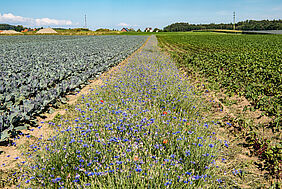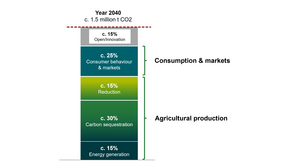(Frick, 22 April 2022) In the light of increasingly evident, human-induced climate change, low-carbon production and consumption patterns are essential for society as a whole and must be pursued by all sectors of the economy. The farming sector, and in particular organic farming with its focus on sustainability, must also face up to this necessity. The study on pathways to carbon-neutral organic farming in Switzerland («Wege zu einer klimaneutralen Biolandwirtschaft in der Schweiz»), prepared in coordination with Bio Suisse, shows for the first time the measures that need to be taken in the farming sector, but also by consumers, in order to achieve carbon-neutrality in organic agriculture in Switzerland, in the sense of net zero greenhouse gas (GHG) emissions.
Markus Steffens, soil and climate researcher at FiBL and co-author of the study, knows that the ambitious «net zero» target in organic agriculture poses major challenges and requires the cooperation of all stakeholders in the entire food system. At the same time, however, he draws attention to the opportunities afforded by carbon-neutral organic farming: «Many of the measures also contribute to climate change adaptation and thus help to ensure food security in the future.» Thus, according to Steffens, with consistent climate change mitigation, the added value in organic agriculture in Switzerland can not only be maintained, but continuously enhanced.
Study results
Proceeding from the baseline data on organic agriculture and climate change mitigation compiled for the study, the FiBL researchers modelled various scenarios to estimate the conditions for achieving carbon-neutral organic agriculture by 2040 and to identify the greatest challenges en route. They arrived at the following results:
- According to the current state of knowledge, the organic farming sector can reduce its greenhouse gas emissions by approximately 15% and offset 45% of its emissions. This will require a wide range of actions and considerable effort on the part of farmers.
- Adjustments in consumer behaviour can reduce agricultural GHG emissions by a further 25%. This requires in particular a lower consumption of livestock-based foods by following the recommended food pyramid diet, and reductions in food waste and food losses.
- Further innovation in agriculture and consumption is also needed by 2040 to achieve the remaining 15% of the target.
On-farm measures
On-farm measures will allow for emissions reductions in the order of 15%. In addition, there is a potential to offset approximately 30% of emissions by means of carbon sequestration (soil organic carbon, plant-based biochar and agroforestry). A further 15% of emissions can be offset indirectly through the production of renewable energy (including agro-photovoltaics). Based on these assumptions and calculations, the farming sector can contribute a total of up to 60% to target attainment.
Consumption and markets
A key contribution to achieving net zero GHG emissions in agricultural production must also be made on the consumer side and in the markets. The study shows that changes here can reduce emissions by about 25%. This would be achieved through reductions in food waste and changes in dietary habits (following the food pyramid concept), and through circular food systems. It would be accompanied by a decrease in the consumption of livestock-based foods and an increase in the consumption of organically produced plant-based foods. Reductions in food waste and food losses would also contribute to reducing the carbon footprint. With regard to the transformation of the food system, cooperation and support for relevant structures on the part of the markets and by means of policy measures will be indispensable.
Innovation
In addition, however, new innovations must be established in agriculture and in the food system to address the remaining 15% share needed for target attainment. Research and advisory services are called upon here to do their utmost.
Further information
For more information on the study details please contact the media office (media(at)fibl.org).
FiBL contacts
- Seraina Siragna
- Markus Steffens
Partner
Bio Suisse





